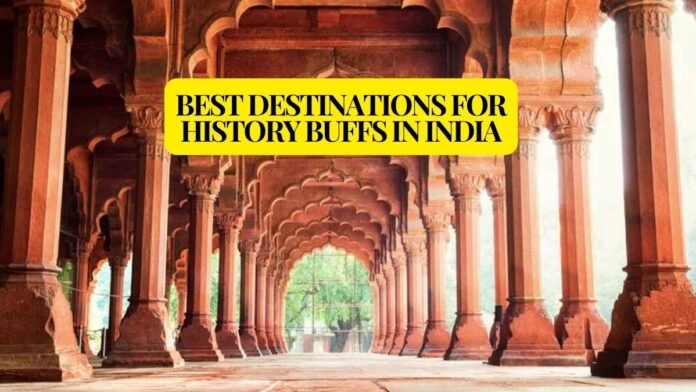For those who enjoy history, historical travel in India offers a wealth of options with its diverse history, culture, and architecture. India’s historical attractions provide a fascinating view into its rich legacy, from elaborate temples and lively markets that recall tales of bygone times to old forts and palaces. These are some of the top historical locations on your travel itinerary if you’re a history fan hoping to learn more about India’s past.
- Delhi: The Heart of Indian History
India’s capital city, Delhi, is a historical wonder with layers of legacy dating back to the Mughal and British Raj periods.
- Red Fort: The principal home of the Mughal emperors, the Red Fort is a notable example of Mughal architecture and is recognized as a UNESCO World Heritage Site.
- Qutub Minar: This imposing minaret, which is a part of a larger complex, was built in the 12th century and is a testament to the Delhi Sultanate’s mastery of architecture.
- Humayun’s Tomb: This magnificent example of a Mughal garden tomb serves as an architectural forerunner to the Taj Mahal.
- Agra: The City of the Taj Mahal
Agra is known with the Taj Mahal, but it also has other historical treasures for anyone interested in India’s Mughal history:
- Taj Mahal: The Taj Mahal is a famous mausoleum known for its exquisite craftsmanship and gorgeous white marble architecture. It was constructed by Emperor Shah Jahan for his loving wife Mumtaz Mahal.
- Agra Fort: The Mughal rulers’ primary residence before the capital was transferred to Delhi was the enormous red sandstone fort known as Agra Fort.
- Fatehpur Sikri: Akbar the Great constructed the ghost town of Fatehpur Sikri, which is a marvel of architecture because of its well-preserved palaces and mosques.
- Jaipur: The Pink City’s Royal Heritage
Rajasthan’s capital city of Jaipur is renowned for its opulent palaces, forts, and lively culture:
- Amber Fort: With breathtaking views of the surroundings, this fort perches on a hill and blends Rajput and Hindu architectural styles.
- City Palace: is a magnificent structure that combines Rajput and Mughal architectural styles and contains a museum containing royal relics.
- Hawa Mahal: Also referred to as the Palace of Winds, this famous building was built with an elaborate façade so that royal women could watch street celebrations covertly.
- Varanasi: The Spiritual Epicenter
One of the oldest towns in the world, Varanasi is an essential hub for comprehending India’s cultural and historical legacy:
- Kashi Vishwanath Temple: With a 5,000-year history, this esteemed Hindu temple honouring Lord Shiva is a significant pilgrimage destination.
- Sarnath: The famous Dhamek Stupa and historic remains can be seen in Sarnath, the location of the Buddha’s first sermon.
- Ramnagar Fort: This lesser-known treasure, which is situated on the banks of the Ganges, symbolizes the historical significance of Varanasi.
- Mysore: The City of Palaces
Karnataka’s Mysore is renowned for its magnificent architecture and royal legacy.
- Mysore Palace: Known for its opulent architecture, the palace is a representation of the Wodeyar dynasty and is the site of several festivals and cultural events.
- St. Philomena’s Church: One of the biggest cathedrals in India, St. Philomena’s Church stands out against the royal palaces with its neo-gothic architecture.
- Chamundi Hill: Known for housing the Chamundeshwari Temple, this hill is important to Mysore’s past and provides sweeping city vistas.
- Hampi: The Ruins of Vijayanagara
Stunning ruins from the Vijayanagara Empire can be found at Hampi, a UNESCO World Heritage Site:
- Virupaksha Temple: One of the oldest still-existing temples in India, this ancient temple is devoted to Lord Shiva.
- Hampi Bazaar: The once-bustling Hampi Bazaar is now a fascinating place to explore the ruins of a major trading centre.
- Vijaya Vittala Temple: This temple complex is a monument to Vijayanagara’s magnificence, known for its melodic pillars and finely carved stone chariot.
- Hyderabad: A Blend of Cultures
Hyderabad provides a distinctive historical experience with its blend of Deccan, Mughal, and Persian influences:
- Charminar: Hyderabad’s famous landmark, the Charminar, provides information about the city’s illustrious past.
- Golconda Fort: An imposing stronghold with a convoluted past, well-known for its fights and acoustics.
- Qutb Shahi Tombs: Known for its distinctive architectural style, these tombs serve as the ultimate resting place for the Qutb Shahi monarchs.
Conclusion
India’s historical sites offer a glimpse into its varied and abundant past. These places offer a fascinating journey through time, from the exquisite features of ancient temples to the majesty of Mughal architecture. For those who are interested in history, visiting these sites offers a deeper look into India’s cultural past than just a typical tourism experience. Every location, whether you’re exploring the ruins of Hampi or gazing at the Taj Mahal, has a history that has influenced the nation’s historical terrain.



